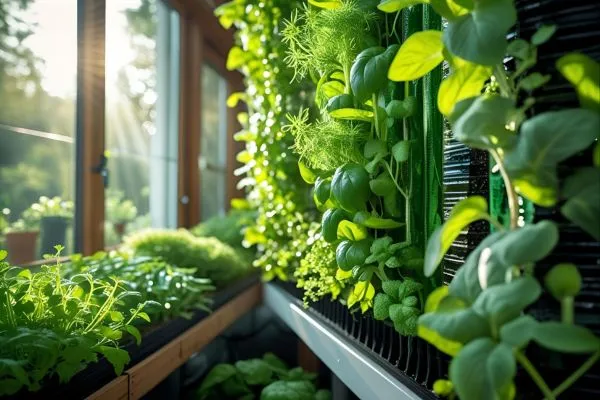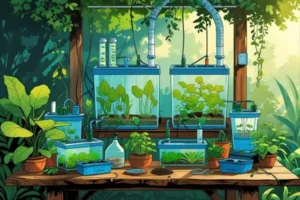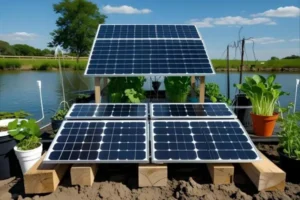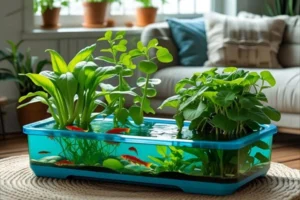Did you know that by 2050, nearly 68% of the world’s population will live in urban areas, yet traditional farming requires vast horizontal spaces that simply don’t exist in cities? With urban populations consuming over 70% of global food production while occupying less than 3% of the Earth’s surface, the challenge of feeding growing cities has never been more pressing.
The problem is clear: limited growing space in urban environments is forcing us to rethink how we produce food. Traditional agriculture demands extensive land use, but city dwellers have only rooftops, balconies, basements, and small yards to work with. Even conventional horizontal aquaponics systems, while efficient, still require significant floor space that most urban growers simply don’t have.
Enter vertical aquaponics – a revolutionary approach that turns the constraints of urban living into opportunities for abundant food production. By growing upward instead of outward, vertical aquaponics systems can produce 3-5 times more food per square foot than traditional methods.
This complete guide will walk you through everything you need to know about vertical aquaponics systems, from understanding the core principles to setting up your own space-efficient food production system. Whether you’re a urban homesteader, apartment dweller, or commercial grower, you’ll discover how to maximize your harvest while minimizing your footprint.
What is Vertical Aquaponics and How Does It Work?
Definition and Core Principles
Vertical aquaponics is an innovative food production method that combines aquaculture (fish farming) and hydroponics (soilless plant cultivation) in a vertically stacked configuration. Unlike traditional farming that spreads horizontally across large areas, vertical aquaponics systems grow upward, utilizing multiple levels or tiers to maximize production within a minimal footprint.
The core principle remains the same as horizontal aquaponics: fish waste provides natural fertilizer for plants, while plants filter and clean the water for fish. However, vertical systems arrange these components in towers, columns, or stacked configurations, creating a living ecosystem that reaches skyward instead of sprawling outward.
Vertical vs. Traditional Horizontal Aquaponics
Traditional horizontal aquaponics systems typically feature large, ground-level grow beds arranged side by side, requiring substantial floor space. A standard home system might occupy 100-200 square feet to produce meaningful harvests. In contrast, vertical aquaponics systems can achieve the same production in just 25-50 square feet by utilizing vertical space up to 8-10 feet high.
Vertical systems also offer better ergonomics, allowing growers to harvest at comfortable heights rather than bending down to ground-level beds. Additionally, vertical arrangements create natural microclimates within the system, enabling different plant varieties to thrive at various levels based on light exposure and airflow patterns.
The Nitrogen Cycle in Vertical Systems
The nitrogen cycle in vertical aquaponics follows the same biological process as horizontal systems. Fish produce ammonia-rich waste, beneficial bacteria (Nitrosomonas and Nitrobacter) convert ammonia to nitrites and then nitrates, and plants absorb these nitrates as nutrients. However, vertical systems require careful consideration of water flow dynamics, pressure management, and even distribution to ensure all plant levels receive adequate nutrients throughout the nitrogen conversion process.
Key Benefits of Vertical Aquaponics Systems
Space Efficiency and Urban Farming Potential
Vertical aquaponics systems revolutionize urban food production by maximizing growing capacity within constrained spaces. A typical 4-foot by 4-foot vertical tower can accommodate 50-80 plants compared to just 16-20 plants in the same floor space using traditional horizontal beds. This 300-400% increase in plant density makes vertical aquaponics ideal for urban environments where every square foot counts.
Urban applications are virtually limitless: apartment balconies, rooftops, basements, garages, and even indoor spaces with artificial lighting can house productive vertical systems. Cities like Singapore and the Netherlands are already implementing commercial vertical aquaponics in urban warehouses, producing fresh vegetables year-round for local communities.
Increased Yield per Square Foot
Beyond space efficiency, vertical systems deliver impressive productivity gains. Research from Arizona State University demonstrates that vertical aquaponics can produce 3-5 times more food per square foot than conventional farming and 2-3 times more than horizontal aquaponics. A well-designed 6-foot vertical tower occupying just 9 square feet can yield 40-60 pounds of leafy greens annually, equivalent to the output of a 30-40 square foot traditional garden bed.
Water Conservation Advantages
Vertical aquaponics systems use 90-95% less water than conventional soil farming and 20-30% less than horizontal aquaponics due to optimized circulation patterns and reduced evaporation surface area. The closed-loop design recirculates water efficiently through multiple growing levels, while the vertical structure minimizes water loss to evaporation.
Energy Efficiency Considerations
Modern vertical systems incorporate energy-efficient LED lighting and gravity-fed water circulation, reducing power consumption by 40-50% compared to traditional greenhouse operations. The compact design also reduces heating and cooling costs, as the smaller growing volume requires less climate control energy. Solar panels can easily power small residential vertical systems, making them completely energy-independent.
Types of Vertical Aquaponics Systems
Tower Systems and Vertical NFT
Vertical NFT (Nutrient Film Technique) systems feature plants growing in vertical tubes or channels with a thin film of nutrient-rich water flowing down from top to bottom. These systems typically use PVC pipes with holes cut at regular intervals, allowing plant roots to access the flowing nutrient solution. Tower NFT systems excel for leafy greens like lettuce, spinach, and herbs, with each 6-foot tower accommodating 30-50 plants. The continuous water flow ensures consistent nutrient delivery, while the lightweight design makes installation and maintenance straightforward.
Stacked Media Bed Systems
Stacked media bed systems arrange traditional grow beds in multiple tiers, creating a vertical growing structure. Each level contains expanded clay pebbles, gravel, or other growing media that supports plant roots and beneficial bacteria colonies. Water flows from the fish tank to the top bed, then cascades through each level via gravity or pump systems. These systems handle a wider variety of plants, including root vegetables and small fruiting plants, due to the stable growing medium. A typical 3-tier system can produce the equivalent of 12 square feet of growing space in just 4 square feet of floor area.
Zip Grow Towers and Vertical Columns
Zip Grow towers utilize specialized fabric matrix media arranged in vertical columns, providing excellent root support and aeration. These systems combine the benefits of both NFT and media beds, offering superior plant stability while maintaining efficient nutrient flow. The towers can reach 6-8 feet in height and accommodate 40-60 plants per tower, making them ideal for commercial applications.
Hybrid Vertical Designs
Hybrid systems combine multiple vertical growing methods within a single setup. For example, a system might feature NFT towers for leafy greens, stacked media beds for herbs, and floating rafts for larger plants. This diversity maximizes crop variety and optimizes each growing method for specific plant types, creating a comprehensive food production system in minimal space.
Best Plants for Vertical Aquaponics
Leafy Greens and Herbs
Leafy greens are the superstars of vertical aquaponics, thriving in the nutrient-rich, space-efficient environment these systems provide. Lettuce varieties (buttercrunch, romaine, red leaf) mature in just 28-35 days and weigh only 4-8 ounces per plant, making them perfect for vertical structures. Spinach, arugula, and kale grow exceptionally well, with kale producing continuously for 6-8 months when properly maintained.
Herbs are equally successful in vertical systems. Basil varieties yield 2-4 ounces of fresh leaves weekly per plant, while cilantro, parsley, and chives provide continuous harvests. Mediterranean herbs like oregano, thyme, and rosemary adapt well to the consistent moisture levels, though they prefer upper levels with better drainage. A single 6-foot tower can support 20-30 herb plants, providing fresh seasonings year-round.
Fruiting Plants Considerations
While challenging, certain fruiting plants can succeed in vertical aquaponics with proper support and spacing. Cherry tomatoes, small pepper varieties, and strawberries work best due to their manageable size and weight. However, these plants require stronger structural support, typically 18-24 inch spacing, and additional calcium supplementation to prevent blossom end rot. Determinate tomato varieties are preferred over indeterminate types due to their controlled growth habits.
Root Vegetables Limitations
Traditional root vegetables like carrots, potatoes, and radishes face significant limitations in vertical systems. Deep-rooted vegetables require 12-18 inches of growing medium depth, which most vertical systems cannot accommodate efficiently. However, shorter varieties like baby carrots, small radishes, and green onions can succeed in deeper media bed systems with at least 8-10 inches of growing medium.
Plant Spacing and Weight Distribution
Proper spacing prevents overcrowding and ensures adequate light penetration. Leafy greens require 6-8 inch spacing, herbs need 4-6 inches, and fruiting plants demand 12-18 inches. Weight distribution is crucial – place heavier plants on lower levels and lighter leafy greens on upper tiers to maintain structural stability and prevent tower collapse.
Fish Selection for Vertical Systems
Suitable Fish Species
Tilapia remains the gold standard for vertical aquaponics systems due to their exceptional adaptability and robust waste production. These hardy fish tolerate temperature fluctuations (65-85°F), produce nutrient-rich waste ideal for plant growth, and reach harvest size (1-2 pounds) in 6-9 months. Blue tilapia and Nile tilapia varieties are particularly well-suited for beginners, as they forgive water quality mistakes that might devastate more sensitive species.
For cooler climates, trout species excel in vertical systems with proper temperature control. Rainbow trout thrive in 50-65°F water and provide excellent protein while producing substantial plant nutrients. However, they require consistent water quality and higher dissolved oxygen levels, making them better suited for experienced growers.
Catfish, particularly channel catfish, offer another excellent option for vertical systems. They tolerate crowded conditions, have minimal lighting requirements (beneficial for indoor vertical systems), and produce significant waste for plant nutrition. Ornamental fish like goldfish and koi work well in smaller residential vertical systems, providing nutrients without harvest pressure.
Stocking Density Considerations
Vertical systems typically use higher fish stocking densities than horizontal systems due to improved water circulation and filtration efficiency. The recommended stocking density ranges from 1 pound of fish per 5-10 gallons of tank water, compared to 1 pound per 10-20 gallons in traditional systems. This increased density produces more nutrients for the expanded vertical growing capacity while maintaining water quality through enhanced biological filtration.
Tank Placement and Accessibility
Fish tank placement in vertical systems requires careful planning for feeding, cleaning, and monitoring access. Ground-level placement provides easy maintenance access but may require stronger pumps to reach upper growing levels. Elevated tank placement (2-3 feet) utilizes gravity for water distribution, reducing energy costs, but complicates cleaning and fish observation. Many successful vertical systems incorporate viewing windows and automated feeding systems to address accessibility challenges while maintaining optimal tank placement for system efficiency.
Step-by-Step Setup Guide for Vertical Aquaponics
Planning and Design Considerations
Begin by selecting your location, ensuring access to electricity, water, and adequate structural support for 200-400 pounds of total system weight. Measure your vertical space – most residential systems work best between 6-8 feet tall to maintain easy access to upper levels. Calculate your desired plant capacity: a 4-foot diameter tower supports 40-60 plants, requiring a 100-150 gallon fish tank for proper nutrient production.
Design your water flow pattern, planning for 300-500 gallons per hour circulation rate. Gravity-fed systems reduce energy costs but require elevated tanks, while pump-driven systems offer more flexible placement options.
Materials and Equipment Needed
Essential components include: 100-200 gallon fish tank, submersible water pump (500+ GPH), PVC pipes (4-6 inch diameter for towers), growing medium (expanded clay pebbles or rockwool), air pump and stones for fish tank aeration, pH testing kit, water heater (if needed), and timer for pump cycles.
For tower construction: drill with hole saw attachment, PVC couplings and elbows, water distribution manifolds, plastic plant cups, and structural support framework (metal or wood).
Construction Process
Start with the fish tank setup – install aeration system and test for leaks. Construct your vertical towers by drilling 3-inch holes every 8-10 inches in PVC pipes, ensuring proper drainage between levels. Install the water pump and distribution system, creating even flow to all growing levels.
Mount towers securely to prevent tipping, using guy-wires or solid framework support. Connect all plumbing components and test water circulation before adding growing medium.
System Cycling and Startup
Fill the system with dechlorinated water and add beneficial bacteria supplement to establish the nitrogen cycle. Run the system fishless for 2-3 weeks, testing ammonia and nitrite levels daily. Add fish gradually once ammonia and nitrites consistently read zero and nitrates appear. Begin planting 1-2 weeks after fish introduction, starting with hardy leafy greens before expanding to other varieties.
Common Challenges and Solutions
Structural Support and Weight Distribution
Vertical aquaponics systems face significant structural challenges, with fully loaded towers weighing 300-500 pounds. The most common failure point occurs when towers become top-heavy with mature plants, causing instability or collapse.
Solution: Install proper foundation support using concrete pads or reinforced flooring rated for 100+ pounds per square foot. Implement guy-wire systems or rigid framework bracing every 3-4 feet of height. Distribute weight by placing heavier fruiting plants on lower levels and lightweight leafy greens above. Consider modular tower designs that allow weight distribution across multiple smaller units rather than single massive towers.
Water Flow and Pressure Issues
Uneven water distribution plague many vertical systems, with upper levels receiving adequate flow while lower sections become waterlogged or nutrient-deficient. Pump failures and clogged distribution lines compound these problems.
Solution: Install pressure-regulating valves and individual flow controls for each growing level. Use larger diameter distribution pipes (1-2 inches) to prevent clogs and maintain consistent pressure. Implement backup pump systems or gravity-fed reservoirs for emergency water circulation. Clean distribution lines monthly and install inline filters to prevent debris buildup.
Light Penetration and Supplemental Lighting
Dense vertical systems create significant shading, with lower plants receiving 50-70% less light than upper levels. This leads to leggy growth, reduced yields, and plant mortality in lower tiers.
Solution: Install full-spectrum LED grow lights positioned strategically between tower levels, providing 20-40 watts per square foot of growing space. Use reflective materials around growing areas to maximize light efficiency. Rotate plants weekly between levels, moving mature plants down and young seedlings up to ensure even light exposure.
Maintenance Accessibility
Reaching upper levels for harvesting, pruning, and system maintenance becomes challenging in tall vertical systems, leading to neglected plants and degraded performance.
Solution: Design systems with maximum 7-foot height for comfortable reach. Install permanent ladders, platforms, or rolling maintenance stands for safe access. Implement removable tower sections or sliding mechanisms that allow easy access to all growing levels.
Cost Analysis and ROI for Vertical Systems
Initial Setup Costs
Small residential vertical aquaponics systems (40-60 plants) require an initial investment of 800-1,500 USD for quality components. This includes a 100-gallon fish tank (150-250 USD), submersible pump and aeration system (200-300 USD), PVC tower materials (150-250 USD), growing medium (100-150 USD), LED lighting (200-400 USD), and miscellaneous plumbing components (100-200 USD).
Medium-scale systems (100-150 plants) cost 2,000-4,000 USD, while commercial vertical setups (500+ plants) range from 10,000-25,000 USD depending on automation levels and climate control requirements. These costs compare favorably to traditional greenhouse construction at 15-35 USD per square foot.
Operating Expenses
Monthly operating costs for residential systems typically run 30-60 USD, including electricity (15-30 USD for pumps and LED lights), fish food (5-10 USD), water quality testing supplies (3-5 USD), and plant seeds/seedlings (7-15 USD). Annual replacement costs for pumps, filters, and growing medium add approximately 100-200 USD per year.
Commercial systems see economies of scale, with operating costs dropping to 0.50-1.00 USD per plant per month for larger installations.
Expected Yields and Revenue Potential
Well-managed vertical systems produce 3-5 harvests annually, yielding 40-60 pounds of leafy greens from a 60-plant residential tower. At current organic produce prices (4-8 USD per pound for premium lettuce, 12-20 USD per pound for fresh herbs), annual production value ranges from 600-1,200 USD per tower.
Commercial operations achieve higher yields through optimization, producing 8-15 USD per square foot annually compared to 2-4 USD for traditional farming.
Break-Even Analysis
Residential systems typically achieve break-even within 12-18 months when replacing store-bought organic produce. The payback period shortens to 8-12 months for households consuming significant quantities of fresh herbs and specialty greens.
Commercial vertical aquaponics operations targeting local restaurants and farmers’ markets can achieve profitability within 18-24 months, with annual ROI reaching 25-40% after the initial payback period.
Maintenance and Monitoring
Daily Monitoring Tasks
Successful vertical aquaponics requires consistent daily attention to key system parameters. Check water temperature (should remain between 68-78°F for optimal fish and plant health), ensuring it doesn’t fluctuate more than 2-3°F within 24 hours. Monitor fish behavior during feeding times – healthy fish should eagerly consume food within 3-5 minutes, with any uneaten food indicating potential health issues or overfeeding.
Visually inspect plant health across all vertical levels, looking for wilting, yellowing leaves, or pest presence. Upper levels typically show stress first due to higher light exposure and faster water evaporation. Check water flow to ensure even distribution – each growing level should receive steady, consistent flow without pooling or dry spots.
Weekly Maintenance Routines
Test water quality parameters using reliable test kits: pH levels should stay between 6.8-7.2, ammonia at 0 ppm, nitrites at 0 ppm, and nitrates between 5-150 ppm. Record these measurements in a maintenance log to track trends and identify problems early.
Clean pump filters and remove any debris from water intake areas. Harvest mature plants and replant empty spaces to maintain continuous production. Prune overgrown plants, particularly removing lower yellowing leaves that block light penetration to plants below.
Monthly System Checks
Conduct comprehensive equipment inspections, checking pump performance, electrical connections, and structural stability. Clean algae buildup from tanks and growing containers using aquaponics-safe methods. Replace any worn or damaged components before they cause system failures.
Perform partial water changes (10-15% of total system volume) if nitrate levels exceed 150 ppm or pH drifts outside optimal ranges. Test backup systems including secondary pumps and emergency aeration equipment.
Seasonal Adjustments
Adjust lighting schedules and intensity based on seasonal changes – winter months may require 14-16 hours of supplemental LED lighting, while summer periods might need only 8-10 hours. Monitor and adjust heating/cooling systems to maintain stable temperatures year-round.
Modify fish feeding rates based on temperature changes – reduce feeding by 25-30% during cooler months when fish metabolism slows. Plan crop rotations to maximize seasonal growing advantages for different plant varieties.
Future of Vertical Aquaponics
Technological Innovations
The future of vertical aquaponics lies in advanced automation and precision agriculture technologies. Internet of Things (IoT) sensors now monitor pH, dissolved oxygen, temperature, and nutrient levels in real-time, automatically adjusting system parameters within 0.1-unit precision ranges. Artificial intelligence algorithms analyze plant growth patterns, predicting optimal harvest timing within 24-48 hours and maximizing yield efficiency by 15-25% compared to manual management.
Emerging LED technology promises 40-50% energy reductions while delivering full-spectrum lighting optimized for specific plant growth phases. Smart vertical towers equipped with individual plant monitoring can adjust water flow, nutrients, and lighting for each growing level independently, potentially increasing yields by 30-40% over current uniform systems.
Integration with Smart Systems and IoT
Next-generation vertical aquaponics systems integrate seamlessly with home automation platforms, allowing remote monitoring via smartphone apps and voice-controlled adjustments. Predictive maintenance algorithms analyze pump performance, filter efficiency, and component wear patterns, scheduling maintenance before failures occur and reducing downtime by 60-80%.
Machine learning systems optimize energy consumption by coordinating lighting, heating, and pump cycles with local utility rates, potentially reducing operating costs by 20-35%. Cloud-based data analytics compare performance across thousands of systems worldwide, providing personalized recommendations for maximizing productivity.
Sustainability Trends
Vertical aquaponics aligns perfectly with global sustainability goals, using 90-95% less water than traditional farming while producing 3-4 times more food per square foot. Future systems will incorporate renewable energy sources, with solar-powered operations achieving complete energy independence for residential installations.
Market Growth and Adoption
The global vertical farming market, valued at 5.5 billion USD in 2023, is projected to reach 24.8 billion USD by 2030, with aquaponics representing 15-20% of this growth. Urban agriculture initiatives in major cities are driving adoption, with vertical aquaponics systems planned for integration into residential developments, schools, and community centers.
Commercial vertical aquaponics facilities are expanding rapidly, with automated systems producing fresh food year-round within 50 miles of major metropolitan areas, reducing transportation costs and carbon footprints by 70-80%.
Conclusion
Vertical aquaponics systems represent a revolutionary approach to sustainable food production, combining the efficiency of soilless cultivation with the environmental benefits of fish farming in compact, space-maximizing designs. These innovative systems deliver 3-4 times more produce per square foot than traditional methods while using 90-95% less water, making them ideal solutions for urban environments, small properties, and resource-conscious growers.
From NFT towers producing 40-60 plants in minimal floor space to sophisticated DWC systems generating 600-1,200 USD annually in organic produce value, vertical aquaponics offers scalable options for every grower level. The initial investment of 800-1,500 USD for residential systems pays for itself within 12-18 months through reduced grocery costs and premium homegrown food quality.
The integration of IoT sensors, LED technology, and automated monitoring systems is transforming vertical aquaponics from experimental setups into precision agriculture platforms. With the global vertical farming market projected to reach 24.8 billion USD by 2030, early adopters position themselves at the forefront of agricultural innovation.
Whether you’re a beginner seeking fresh herbs year-round or an entrepreneur exploring commercial opportunities, vertical aquaponics provides a sustainable path toward food security and environmental stewardship. The combination of technical precision, biological harmony, and spatial efficiency creates growing systems that produce exceptional results while minimizing environmental impact.
What aspects of vertical aquaponics interest you most? Share your questions, experiences, or plans for starting your own vertical system in the comments below – I’d love to help you succeed with your aquaponics journey!
Frequently Asked Questions (FAQ)
How much space do I need for a vertical aquaponics system?
Residential vertical systems require as little as 6-10 square feet of floor space while producing equivalent yields to 50-80 square feet of traditional garden beds. Most towers stand 6-8 feet tall and accommodate 40-60 plants in a 4-foot diameter footprint. Ensure adequate structural support for 300-500 pounds total system weight and allow 2-3 feet clearance around the system for maintenance access.
What’s the minimum budget needed to start vertical aquaponics?
A basic DIY vertical system costs 800-1,200 USD including fish tank, pump, PVC materials, growing medium, and basic lighting. Monthly operating expenses run 30-50 USD covering electricity, fish food, and supplies. Systems typically achieve break-even within 12-18 months through reduced grocery costs.
Can vertical systems produce enough food for a family?
A single 60-plant vertical tower produces 40-60 pounds of leafy greens annually, equivalent to 15-20% of a family’s fresh vegetable needs. Multiple towers or larger commercial-scale systems can provide 80-100% of household fresh produce requirements year-round.
What fish work best in vertical aquaponics systems?
Tilapia thrive in 75-85°F water and tolerate varying conditions, making them ideal for beginners. Trout prefer cooler temperatures (60-70°F) and produce excellent yields in climate-controlled environments. For smaller systems, ornamental fish like goldfish or koi provide adequate nutrients for 20-40 plants while requiring minimal care.
How often do vertical systems need maintenance?
Daily monitoring takes 5-10 minutes checking water flow, fish behavior, and plant health. Weekly tasks include water testing and harvesting, requiring 30-45 minutes. Monthly deep cleaning and equipment inspection takes 2-3 hours. Automated systems reduce daily maintenance to 2-3 minutes using smartphone monitoring.
Do I need prior experience with aquaponics?
No prior experience is necessary. Start with hardy plants like lettuce and herbs, which tolerate beginner mistakes. Follow established cycling procedures, maintain consistent water parameters, and join online communities for support and troubleshooting guidance.



